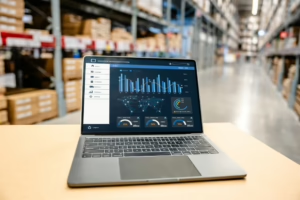
In today’s competitive market, distributors can’t afford to rely on outdated or generic metrics. The right distribution KPIs do more than track activity—they shine a light on the levers that directly drive performance, profitability, and growth.
For small and mid-sized distributors, the challenge isn’t just collecting data—it’s knowing what to measure and why. The key is identifying KPIs that align with your business model, highlight inefficiencies, and support faster, more confident decision-making.
Why Distribution KPIs Matter More Than Ever
Many distributors track standard metrics like revenue, order volume, and inventory turns. While these provide helpful snapshots, they often miss the deeper operational dynamics that influence cost control and customer value.
Effective distribution KPIs act as early warning systems. They reveal where margins are thinning, where service is slipping, and where bottlenecks are building—before those issues become costly. With labor tight and margins under pressure, smart KPI tracking is no longer optional.
Focus on KPIs That Reflect Execution, Not Just Activity
Choosing high-impact KPIs requires a shift from activity-based metrics to execution-based insights. That means looking beyond how much you’re doing and examining how well you’re doing it.
Here are a few core distribution KPIs worth prioritizing:
- Fill Rate – A direct indicator of your ability to meet demand. Low fill rates can signal issues in forecasting, procurement, or inventory management.
- Order Cycle Time – Measures speed and efficiency from order entry to delivery. Reducing cycle time improves customer experience and frees up working capital.
- Inventory Carrying Cost – Tracks the hidden cost of excess inventory—space, insurance, depreciation, and lost opportunity.
- Perfect Order Rate – Combines accuracy, timeliness, and completeness. A high perfect order rate is a strong indicator of overall operational health.
- Gross Margin by Customer or Product – Drills into where you’re making money versus where you’re just moving volume.
Each of these business KPIs offers real visibility into performance drivers that can be optimized over time with the following tips in mind:
Turn KPIs into Action, Not Just Dashboards. The most valuable distribution KPIs are the ones that inform decisions and lead to action. That’s why it’s essential to embed your KPIs into regular workflows—not just monthly dashboards.
When frontline teams can see the impact of their actions on key metrics, they’re more likely to adjust behavior. When leadership can trust the data, they’re more likely to make bold, proactive moves. KPIs become a management tool, not a report.
Tailor KPIs to Your Distinct Business Model. Not all metrics matter equally across the board. A hybrid distributor-manufacturer with complex fulfillment requirements will need different visibility than a regional wholesaler with tight turns and limited SKUs.
Take the time to customize your KPI suite to your operating model. Align them with your strategic priorities: Do you want to grow margins? Improve service levels? Reduce working capital? Your distribution KPIs should reflect those aims clearly.
Realize that KPI Visibility is Your Competitive Edge. You don’t need more data—you need clearer signals. Distributors who optimize for visibility and simplicity in their KPIs move faster and smarter than their peers.
In an environment where complexity is rising and expectations are higher, the companies with strong KPI discipline gain real operational leverage. They make better decisions, sooner—and with more confidence.








